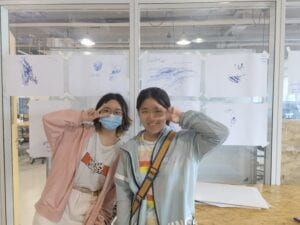INTERACTION LAB RECITATION 4
Recitation 4: Drawing Machines
The disclaimer says that this recitation requires us to work at a larger voltage. If the circuit is not built correctly according to the schematic provided, it is possible to damage your computer. This made me very nervous (as I was bringing my new laptop to school for the first time that day). But we learned a way to protect the computer from damage: powering the Arduino through an external USB power supply. It was like magic! After uploading it once with the computer, the Arduino remembered the code and only needed power to run.

The circuit diagrams looked very intimidating, but after a month of practice, we were able to connect them quickly without changing our faces.

My partner and I both successfully completed our respective parts, and when the two were combined, a robotic arm that could hold a pen and draw on paper was born!

At first, the pen couldn’t reach the paper; it just waved in the air. So we put our iPad under the paper to pad it up. The drawing machine began to make great creations!
(However, the movement of its drawing is a bit alarming)


Finally, we named the masterpiece “Drawing Machine’s Beautiful Drawing :)” and signed it with our names. The students’ works were posted on the glass of 825. I think our work is very artistic and takes up a larger percentage of the paper than other students’.


 “CHEESE!”✌
“CHEESE!”✌
This was the first recitation that we finished on our own, without seeking help. And we managed it in a short time – we even had time to slowly and leisurely pack up and leave.
Question 1:
What kind of machines would you be interested in building? Add a reflection about the use of actuators, the digital manipulation of art, and the creative process to your blog post.
I am interested in building a machine that automates the creation of digital art.
Digital art is a variety of creations produced by technology, processes and materials that take advantage of the specificity of electronic devices. Since I have not studied painting systematically but would like to create cool artworks, I would consider digital manipulation of art to achieve this.
An actuator is a device that converts energy into mechanical kinetic energy and can be used to control and drive objects to perform various predetermined actions. The actuator is the bridge between the virtual world of the computer and the circuitry that the user does not often understand, making it something that the user can directly see, hear, or feel. For the drawing machine we make, too many changes are executed in a short time, causing the machine to vibrate. To improve the accuracy of the machine, we may need to replace the actuator or use a special mechanism or algorithm to help reduce the vibration.
As for the creative process, computers “think” differently than humans do. It seems to me that the designer is more like providing a creative background and logic, which the computer then executes, with some audience intervention. No one knows what kind of art will be created until the start button is pressed. That’s the beauty of interactive art.
Question 2:
Choose an art installation mentioned in the reading ART + Science NOW, Stephen Wilson (Kinetics chapter). Post your thoughts about it and make a comparison with the work you did during this recitation. How do you think that the artist selected those specific actuators for his project?
I noticed Douglas Irving Repetto’s Giant Painting Machine. Our recitation work was also a painting machine, and his was significantly larger and more complex.
The electromechanical devices were built of scraps, which is very environmentally friendly and I appreciated that. The machine makes wall-sized drawings on transparent Mylar, while our drawing machine swings to a range of about half an A4 sheet of paper. The system comprises a motorized carriage that moves back and forth across the top of the Mylar, with a motorized painting device loaded with acrylic ink suspended below it. As for the actuator, electronics need to constantly change the speed and direction of the motors controlling the device, so the artist must carefully choose the suitable actuator. The wobbly suspension and erratic changes result in complex motion and create paintings with great visual impact.
This art installation not only demonstrates the concept of environmental protection, but also the ability to create artworks that humans cannot create through the absolute randomness of the computer and the range of painting.